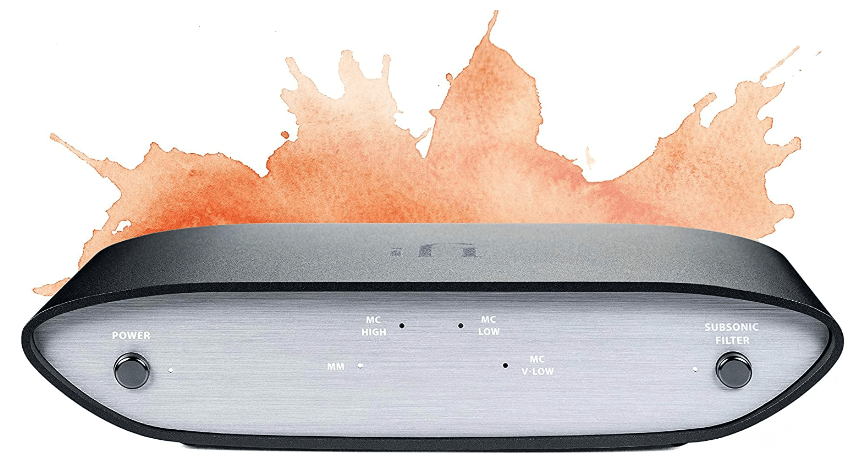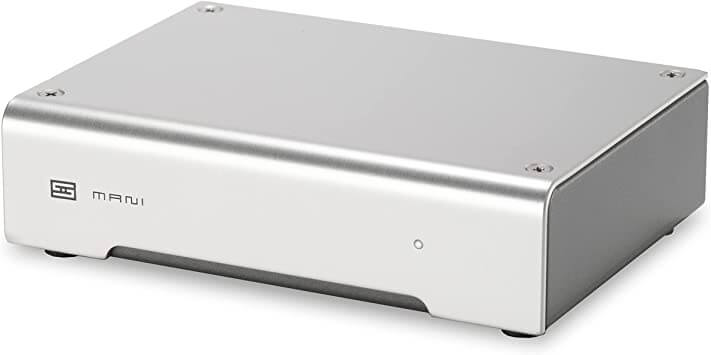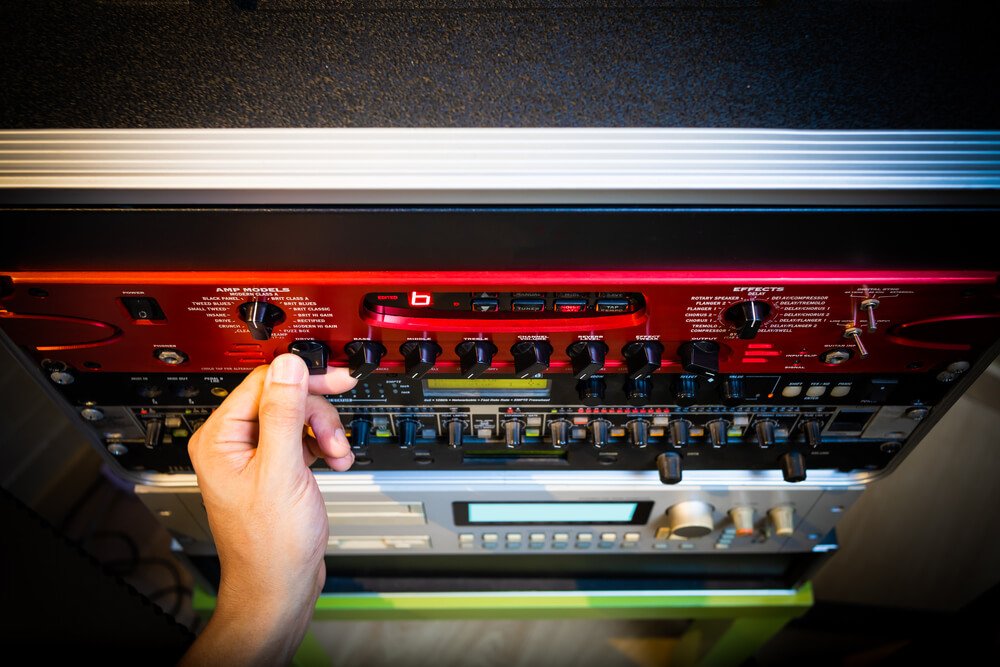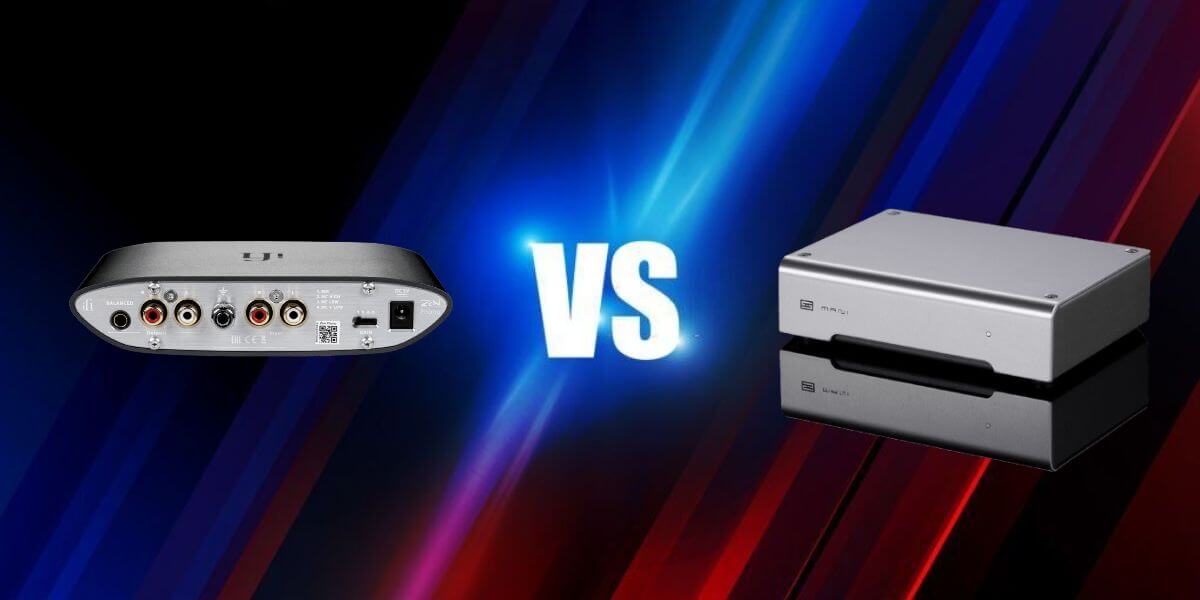If your goal is to complete your turntable setup with a budget-friendly phono preamp stage, or you’re new to turntablism and looking to start with a reliable preamp that combines value and performance, then you’ve come to the right place!
Two of the biggest names you’ll come across in the audiophile equipment industry are iFi Audio and Schiit Audio. Their entry-level phono preamp stages; the ZEN Phono and the Mani, are two of the most popular options among turntablists trying to score the best features and specs at an affordable price.
Today, I’ll be sharing a detailed iFi Zen Phono vs Schiit Mani comparison to help you determine the right choice for your audio needs.
iFi Zen Phono vs Schiit Mani Overview
The iFi Zen Phono excels in mids, highs, and depth. On the other hand, the Schiit Mani offers amazing bass and detailing.
The Zen Phono also provides a switchable subsonic filter and more connectivity options thanks to the balanced output. Looks-wise, the Mani is more “clean” with straight edges and a compact design.
What Is iFi Zen Phono?

Specifications
- External preamp stage designed to connect to your turntable.
- 4 LED indicators and 2 buttons.
- Extra connectivity options such as headphones.
- RCA inputs and outputs, power input, ground input.
- Great staging and timing.
- Super neutral audio and fantastic mids and highs.
iFi Zen Phono is an external preamp stage designed to connect to your turntable. It’s a product made by iFi Audio, a well-known company that was founded back in 2012.
The headquarters of iFi Audio is located in Southport, UK. The brand sources its parts from Japan, Germany, and the USA with a distribution center established in the latter.
At the first glance, you’ll be greeted with a sleek black and silver design. The front panel of this unit shows 4 LED indicators and 2 buttons – one to turn the preamp on and off, and one to engage and disengage the subsonic filter.
On the back of the Zen Photo, you’ll see RCA inputs and outputs, power input, ground input, and the unique Pentaconn balanced output provides you with extra connectivity options such as headphones.
As for the sound output performance, the Zen Phono will provide you with depth like no other. It also offers great staging and timing, with super neutral audio and fantastic mids and highs.
What Is Schiit Mani?

Specifications
- RCA inputs and outputs, power input, ground input, and power switch.
- Gain switches that you can tweak.
- Superb dynamics
- Produces awesome bass.
Schiit Mani is an external preamplifier stage that boosts the signal from your turntable before it reaches the speakers. It’s a product made by Schiit Audio, a widely recognized brand that first came to be back in 2010.
Founded by two audiophiles: Mike Moffat (Theta) and Jason Stoddard (Sumo), Schiit sources its parts and designs/manufactures all its equipment right in the USA.
At the first glance, you’ll be greeted with an all-silver design that looks futuristic to some users and too plain too to others. The front panel of this unit doesn’t have any controls or buttons – there’s just a single LED indicator that lights up when you turn on the preamp.
On the back of the Mani, you’ll see RCA inputs and outputs, power input, ground input, and the power switch. If you flip the unit, you’ll come face to face with gain switches that you can tweak.
When it comes to audio output and performance, the Mani offers superb dynamics and an excellent ability to let every single detail of the sound shine through. It also does a great job with staging and handles timing and pace like a champ.
Additionally, the Schiit Mani is on the warm side of the neutral, so if you’re after some richness in the mid-low frequencies, you should definitely consider this unit. Although it has low mids, the Mani produces awesome bass.
How Are They Different?
The iFi Zen Phono preamp features a button on the front panel that lets you control a subsonic filter function, along with 4 LEDs. On the other hand, the Schiit Mani only has one LED to indicate its power status whereas the power switch is on the back panel.
One area where the iFi Zen Phono has a clear advantage over the Schiit Mani is the depth. Granted, the Mani outputs with wonderful dynamics, staging timing, and pace, but it seems to lack depth sometimes when you compare it head-on to the Zen Phono.
Ultimately, the Zen Photo had better handling over transients, and sometimes, the Mani even sounded a bit more overzealous.
That said, I’d have to give to the Schiit Mani when it comes to bass — it’s rocking, to say the least. But the bass sub-notes have a bit more “oomph” and come out just a little deeper -with a tad longer stretch- on the Zen Phono.
As for the high frequencies, the Mani is the winner when it comes to showing extreme detail. You’ll be able to pick up on the slightest note in the background as you listen.
Users also read: Grado Black 3 vs. Ortofon 2M Red
How Are They Similar?
The components and build quality are very comparable in both the Zen Phono and the Mani, which are generally high quality.
The similarities across the front panel are practically non-existent except for the LED light that indicates power status.
On the other hand, the back panel shares pretty much the same layout that includes RCA inputs and outputs, power input, and ground input.
Another aspect of similarity between the two preamp stages is the warranty. Like most technology-related products, they’re covered with a warranty period from the manufacturers.
iFi Audio backs up the Zen Phono with a 12-month warranty. However, Schiit Audio offers a 24-month warranty on the Mani.
Both warranties are valid starting from the date you’ve purchased the preamp. They’re limited warranties that cover parts and labor, which is very nice given the price point we’re talking about.
What’s Better About iFi Zen Phono?

Unlike the Mani, the Zen Phono allows you to control its power and subsonic filter from the front panel.
The subsonic filter doesn’t exist in the Mani, yet it’s a great feature for when you want to play a warped record. This filter will correct the distortion in the sound output of warped records, but won’t affect the sound of normal records.
I like to leave this function turned on as long as I’m using my setup. This way, even if I unknowingly have a warped record, its sound will be corrected anyway.
Also, I have to say that the brightness of LEDs on the front panel in the Zen Phono is far more user-friendly than those in the Mani.
The latter has a blinding brightness that seriously needs to chill. However, the Zen Phono shines with a comfortable brightness that you can see across the room but without burning your eyes off!
Additionally, the Zen Phono features a Pentaconn balanced output to provide you with extra connectivity options such as headphones.
If you want to establish 2 direct audio signals to two different setups, the Zen Phono supports that. But with the Mani, you need a separate RCA splitter because it lacks the balanced output.
What’s Better About Schiit Mani?
The compact size of the Mani is one of the first things that impressed my space-efficient personality. So if you prefer clean edges and non-awkward outlines, the Mani should be right up your alley!
Also, I highly appreciate that the Schiit Mani is entirely made in the USA, including components like the chassis, boards, and transformers. It makes me feel more confident about the overall quality of the product.
It’s no secret that preamps are usually a lot of work when it comes to settings. Thankfully, beginners can ease their minds a bit with the Mani because it’s all set to plug and play right out of the box for most systems — especially beginner-level turntables carrying MM cartridges.
Features and Specifications Comparison Summary
| Spec/Feature — Phono Preamp Stage | iFi Zen Phono | Schiit Mani |
| Gain Settings (MM/MC High/MC Low/MC Very Low) | 36 dB, 48 dB, 60 dB, and 72 dB (+/- 1dB) | 30 dB, 42 dB, 48 dB, and 59 dB (+/- dB) |
| Signal/Noise Ratio | >94 dB, >84 dB, >79 dB, and >69 dB | >90 dB, >82 dB, >80 dB, and >70 dB |
| Input impedance (MM/MC Low/MC Very Low) | 47k, 1k, and 110 Ohms | 47 or 47k Ohms |
| Output Impedance | 200 Ohms (BAL), 100 Ohms (SE) | 75 Ohms |
| RIAA Response Accuracy | +/- 0.4 dB (MM, 10Hz to 100kHz) | +/- 0.2 dB ( 20Hz to 20kHz |
| Power Consumption | 2.5 W | 4 W |
| Weight | 1.14 pounds | 1 pound |
| Dimensions | 6.3 x 4.4 x 1.4 inches | 5 x 3.5 x 1.25 inches |
Who Should Get iFi Zen Phono?
You should get the iFi Zen Phono preamp if:
- You listen more to rock, jazz, and classical music genres.
- You’re looking for excellent mids and highs.
- You’re after great depth.
- You’re a beginner on a budget.
- You’re a professional looking for a reliable backup.
Who Should Get Schiit Mani?
You should get the Schiit Mani preamp if:
- You listen more to EDM and digital-produced music genres such as House, Dubstep, and Techno.
- You’re looking for outstanding bass.
- You’re after fantastic detailing.
- You’re a beginner on a budget who doesn’t want to worry about upgrading soon.
- You’re a professional mixer looking for a reliable backup.
Users also read: KT88 vs. KT66

